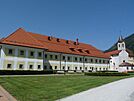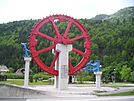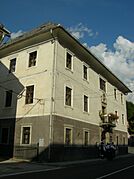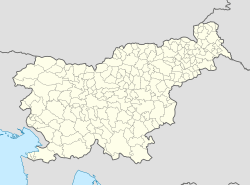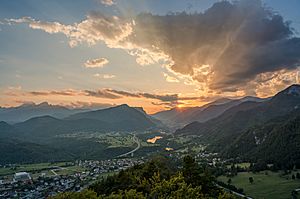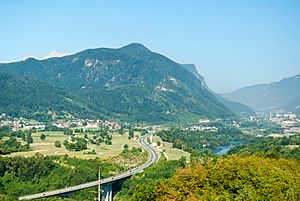Jesenice facts for kids
Quick facts for kids
Jesenice
|
|||
|---|---|---|---|
|
Town
|
|||
|
From top, left to right: Jesenice from above, Workers' Barracks, Assumption and Roch's Church, Bucket Wheel Turbine, Kos Manor, Stara Sava
|
|||
|
|||
| Nickname(s):
Town of steel and daffodils
|
|||
| Country | |||
| Statistical region | Upper Carniola | ||
| Municipality | Jesenice | ||
| Settled | 1538 | ||
| Incorporated | 1929 | ||
| Area | |||
| • Total | 8.5 km2 (3.3 sq mi) | ||
| Elevation | 585 m (1,919 ft) | ||
| Population
(2013)
|
|||
| • Total | 13,255 | ||
| • Rank | 12th, Slovenia | ||
| • Density | 1,552/km2 (4,020/sq mi) | ||
| Time zone | UTC+01:00 (CET) | ||
| • Summer (DST) | UTC+02:00 (CEST) | ||
| Postal code |
4270
|
||
| Area code(s) | 04 (+386 4 from abroad) | ||
| Vehicle registration | KR | ||
| Google Maps | Jesenice, Slovenia | ||
Jesenice is a town in Slovenia. It is the tenth-largest town in the country. Jesenice is located in a region called Upper Carniola. The town sits on the southern side of the Karawanks mountains, close to Slovenia's border with Austria. Jesenice is famous for its history as a mining town. Its ironworks and metal industries were very important for the town's growth.
Contents
History of Jesenice
How Jesenice Got Its Name
The name Jesenice comes from an old word meaning "ash woods." This tells us that there used to be many ash trees in the area. The town was first written about in 1337. Back then, it was called villa de Jesenicza. The German name for the town is Aßling.
Jesenice in the Middle Ages
Jesenice was first mentioned in a document from the year 1004. This document was given by King Henry II of Germany. At that time, there wasn't a town yet, just an area near a creek. Later, a small settlement started to grow.
Most of what we know about early Jesenice is about its iron industry. The first records of mining rights date back to 1381. Early settlements were built on the slopes of the Karawanks mountains. This was because they needed wood, water for mills, and iron ore.
In 1538, the iron industry moved to the Sava Dolinka River. This river had more water power. This move helped create the settlement that became Jesenice. The ironworks continued to get iron ore from the nearby mountains.
Over time, several small villages like Plavž, Sava, Murova, and Slovenski Javornik grew in the area. These villages were all joined together to form the town of Jesenice on March 20, 1929.
Jesenice's Industrial Growth
The different iron factories in Jesenice were owned by different families. These factories were old-fashioned compared to others around the world. Modernizing them needed a lot of money.
In 1869, a new company was formed called the Carniolan Industrial Company (KID). This company helped modernize the iron factories. Soon, all the ironworks in the Upper Carniola region were managed by KID.
A big achievement for KID was finding a new way to make ferromanganese. This discovery won them a gold medal at a big exhibition in Vienna in 1873. This made Jesenice famous worldwide for its ironworking innovations. The town grew quickly as many people came for new jobs.
The Early 20th Century in Jesenice
At the start of the 20th century, Jesenice had many different groups. There were sports clubs like Sokol (Hawk) and Orel (Eagle). There were also choirs, reading clubs, and a brass band. Different political parties also became active.
The first railway tracks were laid through Jesenice in 1870. This helped Jesenice connect better with other places and export its products. In 1905, work began on the Karawanks-Bohinj Railway. This project involved drilling two long tunnels. One tunnel went to Austria, and the other went through Mount Kobla. This made it faster to reach the seaport of Trieste.
In 1904, some parts of the ironworks moved to Slovenski Javornik. To save money, the company wanted to lower workers' pay. This led to a strike by about 400 workers. The strike lasted six weeks, and the workers partly achieved their goals.
Jesenice During World War I and II
During World War I, the Jesenice ironworks mostly made military products for Germany. The war did not directly affect Jesenice much. There was only one bombing attack by Italian planes, but no one was hurt. After the war, Jesenice became part of the Kingdom of Yugoslavia. This opened up new markets. Because it was on the border, Jesenice became an important place for travel and trade.
In World War II, Italy occupied Jesenice in April 1941, and then Germany took over. The Germans knew Jesenice was important for its industry. They tried to make everyone speak German and changed public signs. This led to the creation of a resistance movement called the Partisans.
The steel industry again made products for the German military. The Germans brought in workers from France and Italy. Before the war ended, Jesenice was heavily bombed by Allied forces on March 1, 1945. Many people were hurt, and the town center, including the train station, was badly damaged.
Jesenice After World War II
After World War II, Jesenice's economy grew very well. The ironworks became a major steel producer. It helped rebuild the new country of Socialist Federal Republic of Yugoslavia. More people than ever worked at the ironworks. Many new factories and apartment buildings were built. Jesenice became the main center for black metallurgy in Slovenia.
By the 1970s, the ironworks employed over 8,000 people. However, after Yugoslavia broke apart in 1991, the economy changed. The Jesenice ironworks struggled to compete with Western companies. They also lost access to raw materials from other former Yugoslav republics. This led to many job losses. Since Slovenia became independent, Jesenice has focused on developing other parts of its economy.
Geography and Climate
Jesenice is located in the Upper Sava Valley in the Upper Carniolan region. The town is surrounded by the Karawanks mountains and the Austrian border to the north. To the south is the Mežakla plateau.
A small village called Planina pod Golico is about 5 kilometers north of Jesenice. It is popular with tourists, especially in spring. That's when many beautiful white daffodils bloom there. Other nearby places include Kranjska Gora and the famous tourist spot of Bled.
Jesenice has a climate that is a mix of temperate and continental. It also has some influences from the nearby mountains.
Transportation in Jesenice
Jesenice has good road connections. You can reach it from Austria through the Karawanks Tunnel. From Italy, you can take a regional road through Kranjska Gora. The A2 motorway connects Jesenice to Ljubljana and goes further to Austria and Germany.
Jesenice is an important railway hub. It connects the town with Austria. Daily trains go to Nova Gorica and Italy. International trains from Zagreb also stop in Jesenice on their way to Germany and Switzerland.
Bus services are also well developed. There are many bus stops and connections to other places in Slovenia. Jesenice is only 48 kilometers from Ljubljana Airport.
Education in Jesenice
Jesenice has several schools and a college.
- The Jesenice College of Nursing was started in 2006. It is a college for students who want to become nurses.
- Jesenice Secondary School offers four-year courses in technical and medical subjects. It was founded in 1938.
- Jesenice High School is a preparatory school. It was established in 1945.
- Tone Cufar Primary School is named after a local writer.
- Prezihov Voranc Primary School is named after another writer and activist.
Religion in Jesenice
Most people in Jesenice are Catholics. However, because many workers came to Jesenice for the steel industry, there are also many Muslims from Bosnia and Herzegovina. There are also many Orthodox Christians from Serbia. Some people in Jesenice today say they are atheists.
Jesenice has several religious buildings. These include Catholic churches dedicated to St. Leonard and St. Barbara. There is also the Assumption and St. Roch Church and the Mosque.
Sports in Jesenice
Jesenice is well-known for its ice hockey team, HK Acroni Jesenice.
Industry in Jesenice
The town is home to Acroni, which is the largest steel company in Slovenia.
Things to See and Do in Jesenice
Here are some places you can visit in Jesenice:
- The Jesenice Upper Sava Museum has different collections. You can see ironworks history at Ruard Manor. There are also exhibits about workers' movements and World War II at Kos Manor. An ethnographic collection is at the Worker Barracks.
- One of the tall smokestacks from the old steel mill has been saved as a landmark.
- You can visit the Tone Cufar Theatre and Cinema. There is also an ice hockey rink at Podmežakla Hall.
- The countryside around Jesenice is very scenic. You can hike or cycle to Planina pod Golico or Pristava. In springtime, you'll see fields of white daffodils there. Planina pod Golico is also a good starting point for hikes into the mountains, like to Golica or Vajnež.
Images for kids
Notable People from Jesenice
Many interesting people were born or lived in Jesenice, including:
- Miha Baloh (born 1928), actor
- Helena Blagne Zaman (born 1963), singer
- Tone Čufar (1905–1942), writer
- Anja Klinar (born 1988), swimmer
- Anže Kopitar (born 1987), ice hockey player
- Tomo Križnar (born 1954), peace activist, writer
- Thomas Luckmann (born 1927), sociologist
- Miha Mazzini (born 1961), writer, screenwriter, film director
- Janez Modic (1846 – after 1892), beekeeper
- Odon Peterka (1925–1945), poet
- Teodora Poštič (born 1984), figure skater
- Jure Robič (1965–2010), ultra marathon cyclist
- Miral Samardžić (born 1987), footballer
- Rudi Šeligo (1935–2004), writer and politician
- Rok Urbanc (born 1985), ski jumper
- Gregor Urbas (born 1982), figure skater
- Milena Zupančič (born 1946), actress
- Rašid Mahalbašić (born 1990), professional basketball player



